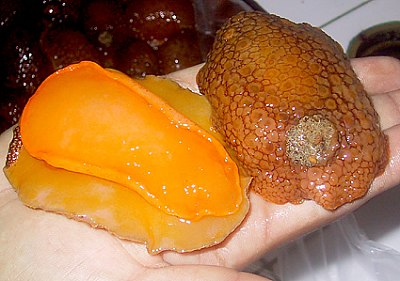
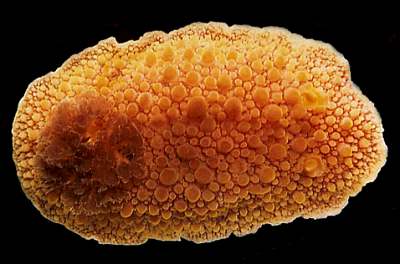
Doris fontainei
d'Orbigny, 1837
Order: NUDIBRANCHIA
Suborder: DORIDINA
Superfamily: EUDORIDOIDEA
Family: Dorididae
DISTRIBUTION
Both Pacific and Atlantic coasts of southern Sth America from northern Argentina to southern Peru.
PHOTO
UPPER: Independence Bay, 260km south of Lima, Peru. 2 to 16 meters deep. 2-9 cm long. Photo: Jorge Luque.
LOWER: Bay of Coliumo, central Chile, 5.5 cm long [see Schroedl (1997b)]. Photo: Michael Schroedl.
The mantle is highly arched and covered in large rounded tubercles which can reach 5mm or more in diameter in the midregion but be somewhat smaller towards the edge. The body ranges in colour from yellow or yellow-orange to brownish and often the space between the tubercles forms a network of brown. Sometimes the center of large tubercles is a darker color than the rest of the tubercle. There are 5-7 large tripinnate gills, and the oral tentacles are flattened and triangular with a groove along the outer edge. The front of the foot is bilabiate, that is split into upper and lower flaps, but the upper flap is not notched. Grow to at least 118mm long and 65mm wide. Schroedl (1997b, 2000) describes the anatomy of this species and compares it with other similar dorids described from the same region. He identifies it as Anisodoris fontaini. In a recent review, Valdés & Muniain (2002) reassess the taxonomy of this species and rename it Doris fontainei. See the attached messages for a discussion about these changes.
References:
• D'Orbigny, A. (1835-46) Voyage dans l'Amérique Méridionale exécuté pendant les années 1826-1833. Vol. 5. Mollusques. Libraire de la Société geologique de France: Paris. 758 pp. plus Atlas.
• Schroedl, M (1997a) Range extensions of Magellanic Nudibranchs (Opisthobranchia) into the Peruvian faunal province. The Veliger, 40(1): 38-42.
• Schroedl, M. (1997b) On the morphology of the Magellanic nudibranch Anisodoris fontaini (D’Orbigny, 1837), and its synonymy with A. tessellata Bergh, 1898. Veliger 40: 228-233.
• Schroedl, M. (2000) Taxonomic revision of the common South American nudibranch Anisodoris fontaini (D’Orbigny, 1837), with discussion of its systematic placement. Journal of Molluscan Studies 66: 49-61.
• Valdés, A. & Muniain, C. (2002). Revision and taxonomic reassessment of Magellanic species assigned to Anisodoris Bergh, 1898 (Nudibranchia: Doridoidea). Journal of Molluscan Studies, 68: 345-351.
Rudman, W.B., 2002 (October 23) Doris fontainei d'Orbigny, 1837. [In] Sea Slug Forum. Australian Museum, Sydney. Available from http://www.seaslugforum.net/find/dorifont
Related messages
Nudibranch from Ica, Peru
May 17, 2010
From: Andre Ampuero
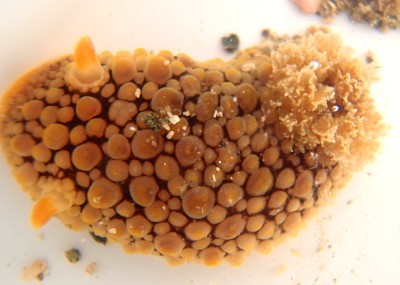
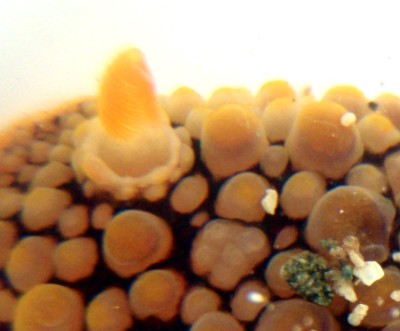
Dear Bill:
I found this nudibranch in Ica. Peru. I have it preserved in ethanol. Sorry if I can't know at least the family, but I am starting to study these molluscs. I would appreciate very much if you could send me some information about this species.
Locality: National Reserve of San Fernando, 20, Ica, Peru, Pacific, 07 April 2010, dredged 16-20 m. Length: 30 - 35 mm. Photographer: Andre Ampuero.
Thanks for helping me.
Andre Ampuero
zero_2488@hotmail.com
Ampuero, A., 2010 (May 17) Nudibranch from Ica, Peru. [Message in] Sea Slug Forum. Australian Museum, Sydney. Available from http://www.seaslugforum.net/find/23633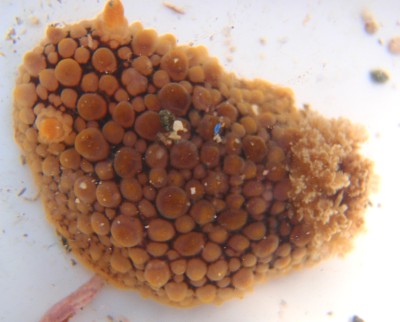
Dear Andre,
I am pretty sure this is Doris fontainei. Most of the photos on the Forum are of animals without the dark brown background colour, but Michael Schroedl in his various publications on the species mentions that it can have such a dark brown background. Have a look at the species fact Sheet and attached messages for further information.
This is an interesting biogeographical find because as Micheal Schroedl mentions in an earlier message [#8283], this species is well-known in southern South America but at present the only known record from as far north as Peru is from Independence Bay [see message #8071]. It is clearly a bit early to say but perhaps this dark brown background colouration will prove to be the usual colour form in animals from the northern part of the species' range.
I am afraid I can't give you a good genus name for the species. It has in recent years been Doris fontainei, Anisodoris fontainei and Archidoris fontainei, reflecting various revisions of higher classification. Unfortunately stability has not as yet been reached so I prefer to leave it as Doris fontainei at present.
If you are planning to study the Peruvian fauna you should obtain a copy of Michael Schroedl's Sea Slugs of Sth America. Considering how unknown the Peruvian fauna is, photos of any of your finds would be very welcome and valuable additions to the Forum.
Best wishes,
Bill Rudman
Doris fontainei from Tristan da Cunha
November 18, 2009
From: Sue Scott
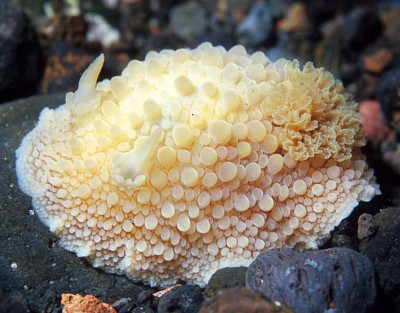
Note: For cross-reference I have posted 3 copies of this message. This copy deals with Doris fontainei. - Bill Rudman
Hello Bill,
I consult your very informative website from time to time to try & identify seaslugs. I'm a marine biologist normally resident in Scotland but I've been running a marine project on Tristan da Cunha for the past few years. Because the island is so isolated and geologically young it has a weird & wonderful fauna, mostly derived from waifs & strays rafted there on marine debris, both natural and manmade. Attached are 3 photos of seaslugs from Tristan, which I have tentatively identified as Tyrinna nobilis [message #22796], Doris/Anisodoris fontainei and Jorunna tomentosa [message #22799]. I'd be grateful for your expert opinion on these ids. Many of Tristan's animals also occur in Chile & Argentina, as is the case with the first two of these seaslugs. If the Jorunna is correct, it maybe came from the South African side.
Locality: Tristan da Cunha, Intertidal pools east of Harbour, British Overseas Territory, South Atlantic Ocean, 2004-2007 (dates available), Extremely exposed rocky coasts. 37 03' 50.94"S, 12 18' 43.64"W. (position derived from Google Earth; note decimal seconds) Photographer: Sue Scott
Regards,
Sue
suescott153@btinternet.com
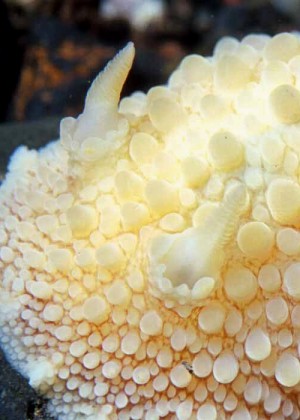
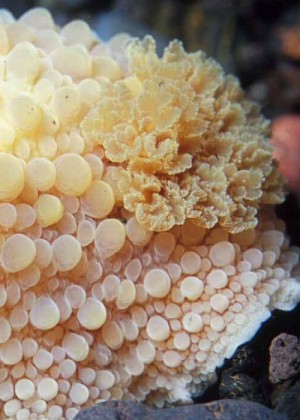
Dear Sue,
It's not always easy to identify these large tuberculate dorids from photos but I would tend to agree with your identification. I am sure if Michael Schroedl or Angel Valdes have their doubts they will let us know. With the addition of Tristan da Cunha, this species and Tyrinna nobilis have very similar geographic ranges.
Best wishes,
Bill Rudman
Re: Peruvian dorid
October 26, 2002
From: Michael Schroedl

PHOTO: The pic shows the individual illustrated by Schroedl (1997b) - 5.5 cm; Bay of Coliumo, central Chile.
Dear Bill,
Yes, Jorge’s dorid definitely is "my old friend" A. fontaini. As you correctly point out, this is the only large cryptobranch dorid species from temperate southeastern Pacific waters that has a yellowish to orange or brown body coloration, usually a dark reticulation between the very large, sometimes flattened tubercles, triangular, grooved oral tentacles, and the upper anterior foot edge not notched. A. fontaini is one of the most common species ranging from northern Argentina throughout the Magellan region and the entire Chilean continental coast. Its northermost record was from Arica, Chile, just a few kilometers south of the Peruvian border (Schroedl, 2000). The present finding by Jorge Luque, as far as I know, is the first record of A. fontaini from Peru and extends its known range by some hundred kilometers to the north.
Possibly due to its wide range, locally high abundance and variable coloration, a bulk of synonyms exists (see Schroedl, 2000). Also the generic placement of A. fontaini is problematic. Recently, Valdés & Gosliner (2001) proposed a new generic arrangement of dorids with caryophyllidiid tubercles, synonymizing the genus Anisodoris with the senior Diaulula. In contrast to other former members of Anisodoris, A. fontaini possesses normal tubercles and triangular oral tentacles; it may be best placed into the genus Archidoris.
I think that many of the opisthobranchs known from central and northern Chile (see Schrödl, 1997a) ultimatively will be found also in Peru. Up to now, the Peruvian coast is one of the poorliest known regions of the world with regard to opisthobranchs – the only significant collectings were those by D’Orbigny (1835-1846)! I can just encourage Jorge to watch out for more opisthobranchs, he will certainly get a host of interesting findings including other range extensions and, presumably, some new species. By the way, I have prepared a catalog of all nudipleuran (Pleurobranchoidea plus Nudibranchia) species from Chile, that is based on extensive recent collectings and revision of almost all relevant type and museum material; it will appear early next year.
References:
• D'Orbigny, A. (1835-46) Voyage dans l'Amérique Méridionale exécuté pendant les années 1826-1833. Vol. 5. Mollusques. Libraire de la Société geologique de France: Paris. 758 pp. plus Atlas.
• Schroedl, M (1997a) Range extensions of Magellanic Nudibranchs (Opisthobranchia) into the Peruvian faunal province. The Veliger, 40(1): 38-42.
• Schroedl, M. (1997b) On the morphology of the Magellanic nudibranch Anisodoris fontaini (D’Orbigny, 1837), and its synonymy with A. tessellata Bergh, 1898. Veliger 40: 228-233.
• Schroedl, M. (2000) Taxonomic revision of the common South American nudibranch Anisodoris fontaini (D’Orbigny, 1837), with discussion of its systematic placement. Journal of Molluscan Studies 66: 49-61.
• Valdes, A & T.M. Gosliner. (2001) Systematics and phylogeny of the caryophyllidia-bearing dorids (Mollusca, Nudibranchia), with descriptions of a new genus and four new species from Indo-Pacific deep waters. Zoological Journal of the Linnean Society 133: 103-198.
All the best for now,
Michael
schroedl@zi.biologie.uni-muenchen.de
Schroedl, M. , 2002 (Oct 26) Re: Peruvian dorid. [Message in] Sea Slug Forum. Australian Museum, Sydney. Available from http://www.seaslugforum.net/find/8283Thanks Michael,
As you suspected, recent work has made the generic position of this species rather tenuous. I noticed yesterday that Valdes & Muniain have just published a paper on the topic (see Angel Valdes' message) suggesting it is best considered a species of Doris. I look forward to your catalogue of Chilean species in the New Year.
Best wishes,
Bill Rudman
Re: Anisodoris from Peru
October 26, 2002
From: Angel Valdes
Dear Bill
I believe the dorid from Peru is Doris fontainei d'Orbigny, 1837, recently redescribed by Schrödl (2000), as Anisodoris fontainei. Valdés & Muniain (2002) transferred this species to the genus Doris and corrected the original spelling of the specific name to fontainei. This species is found from Argentina (37ºS), throughout
Chile, to Peru, between 0-100 m depth.
References:
• Schrödl, M. (2000) Taxonomic revision of the common South American nudibranch Anisodoris fontaini (d'Orbigny, 1837), with discussion of its systematic placement. Journal of Molluscan Studies, 66: 69-81.
• Valdés, A. & Muniain, C. (2002). Revision and taxonomic reassessment of Magellanic species assigned to Anisodoris Bergh, 1898 (Nudibranchia: Doridoidea). Journal of Molluscan Studies, 68: 345-351.
Best regards,
Angel
avaldes@nhm.org
Valdes, A., 2002 (Oct 26) Re: Anisodoris from Peru. [Message in] Sea Slug Forum. Australian Museum, Sydney. Available from http://www.seaslugforum.net/find/8285Thanks Angel,
I have not as yet seen your recently published review of this species (Valdes, A. & Muniain, C. 2002), but the abstract, which I copy below, has some interesting conclusions, which hopefully will untangle the problems surrounding these South American names.
Valdés, A. & Muniain, C. (2002). Revision and taxonomic reassessment of Magellanic species assigned to Anisodoris Bergh, 1898 (Nudibranchia: Doridoidea). Journal of Molluscan Studies, 68: 345-351.
ABSTRACT:
Recent investigations on phylogenetic systematics of cryptobranch dorid nudibranchs indicate that the Magellanic species previously assigned to the genus Anisodoris must be transferred to several different genera. Anisodoris fontainei (d'Orbigny, 1837) is regarded as a member of the genus Doris on the basis of the absence of a notch on the anterior border of the foot and the presence of lateral prolongations in the mouth area, instead of oral tentacles, and a tubular prostate. Anisodoris punctuolata (d'Orbigny, 1837) is regarded as a member of the genus Diaulula because of the presence of caryophyllida, a prostate divided into two portions, and a notched and grooved anterior border of the foot. Anisodoris rudberghi Marcus and Marcus, 1967 and Anisodoris variolata (d'Orbigny, 1837) are transferred to the genus Peltodoris due to the presence of a smooth labial cuticle, a notched and grooved anterior border of the foot, oral tentacles and a prostate with two portions. Since Anisodoris rudberghi is no longer regarded as a member of Anisodoris it has to be replaced by its senior synonym Anisodoris marmorata Bergh, 1898 (in the binomen Peltodoris marmorata), which was previously replaced on grounds of secondary homonymy with Archidoris marmorata Bergh, 1881. The correct spelling Doris fontainei is discussed, versus the original spelling fontainii and the subsequent incorrect spelling fontaini.
Best wishes,
Bill Rudman
Concentration of dorids in Peru
October 24, 2002
From: Jorge Luque

Dear Dr. Rudman:
We have found large Pleurobranchus concentration, (2 to 16 meters deep and added to rock walls and botton), in the Independence Bay, 260km south of Lima, Peru.
They were 2-9cm long. We think they are Pleurobranchus areolatus, but we are not sure because of their strong orange color. They don`t have shell.
We appreciate all your help.
Best Regards,
Jorge Luque.
luque_jorge@klegal.com.pe
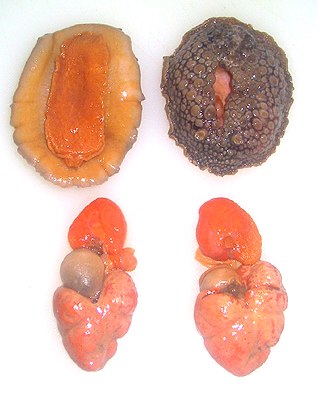
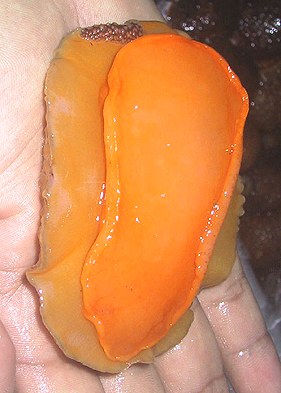
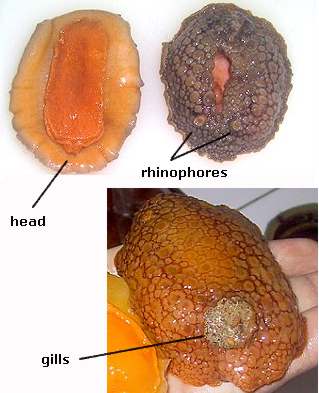
Dear Jorge,
I think this is the is the first opisthobranch from Peru on the Forum! It certainly looks like the photos of Pleurobranchus areolatus from southern California, but this is a dorid nudibranch not a pleurobranch. If this were a pleurobranch there would be a prominent gill on the right side of the body below the mantle. In the photos alongside I have labelled some of the main anatomical features.
I am afraid my only knowledge of Peruvian opisthobranchs is from the few scientific publications from the west coast of South America. Marcus (1959) reports a number of species of Neodoris and Anisodoris from Chile, which have a similar external appearance. I suspect your animal may be a species of Anisodoris. If we are lucky someone may recognise it from your photos.
• Marcus, Er., (1959) Reports from the Lund University Chile Exped. 1948-49, No. 36. Lamellariacea und Opisthobranchia. Lunds Universitets Arsskrift (Ny Foljd), Avd., 2, 55(9): 1-133.
Best wishes,
Bill Rudman
Re: Dorid from Peru
October 24, 2002
From: Bill Rudman
In reference to Jorge's dorid from Peru, I was pretty sure Michael Schroedl had published recently on South American species of Anisodoris but couldn't find the references at home last night. They are:
• Schroedl, M. (1997) On the morphology of the magellanic nudibranch Anisodoris fontaini (d'Orbigny, 1837) and its synonymy with A. tessellata Bergh, 1898. The Veliger, 40(3): 228-233.
• Schroedl, M. (2000) Taxonomic revision of the common South American nudibranch Anisodoris fontaini (d'Orbigny, 1837), with discussion of its systematic placement. Journal of Molluscan Studies, 66: 69-81.
From these papers I am pretty sure this animal is Anisodoris fontaini which Schrodl says has a distribution on the both the Atlantic and Pacific coasts of South America from northern Argentina to the Chile-Peru border. If this is correctly identified, then it also extends further north into Peru. Schrodl considers that a number of species of Anisodoris and Neodoris that have been described from Sth America are synonyms of Anisodoris fontaini. Distinguishing external features, include the large orange-yellow tubercles, usually separated by a darker background colour on the mantle, and triangular grooved oral tentacles.
Best wishes,
Bill Rudman
